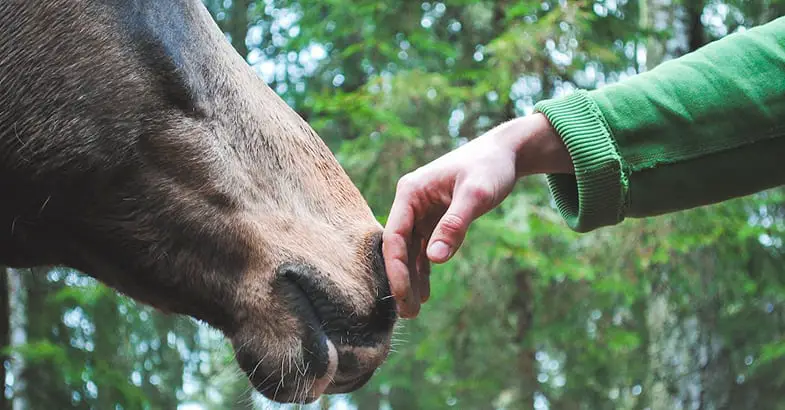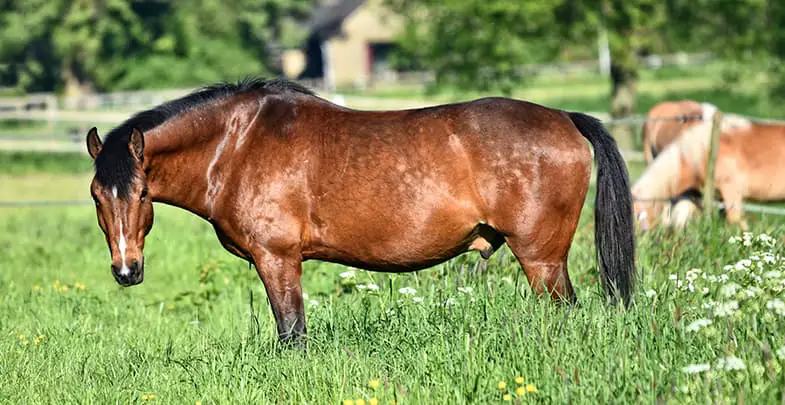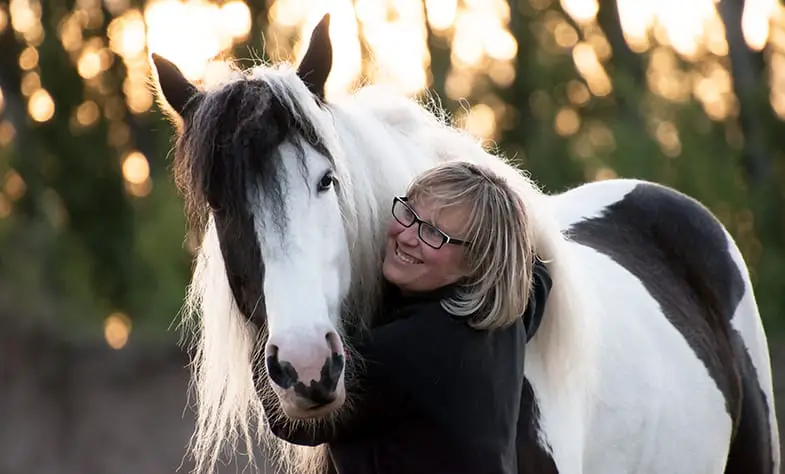Horses are very friendly animals that love human contact and interaction but it’s important that we approach them properly so that we don’t scare them. After all, horses are big animals that can spook easily if they’re startled or if they don’t know you’re there.
The good news is that while you need to be careful about how you approach a horse, when you do it right, most horses will happily stand there and let you pet them.
How do you approach and pet a horse?
Horses are big animals that can cause a lot of damage (even when they don’t mean to) which is why it’s important that you approach and pet them safely and sensibly. In this article, I’ll go into each stage in more detail but to sum it up in a quick list you need to:
- Ask the owner’s permission
- Stay calm and be patient
- Let the horse know you’re there
- Approach the horse slowly
- Pay attention to their body language
- Hold your hand out for them to smell
- Pet the horse’s neck
Be calm and relaxed
Being prey animals horses have learned to live on their instincts and while they may not always be right it’s something that helped them to survive in the wild so it’s important to the horse. In order to work out your intentions and motives they’ll read your body language and mood.
This means that it’s a good idea to approach the horse when you’re feeling calm and relaxed. If you’re in a bad mood or are feeling anxious the horse will interpret this as you having negative energy. Making them less likely to want to approach you, even if you have a treat in your pocket.
If you’re not relaxed then take a few moments to concentrate on your breathing, this will help to relax you and will also help to reassure the horse.
Let the horse know you’re there
Even though horses have very good eyesight they might not have noticed you’re there (even if you’re in their line of sight), this can scare or startle them which is why you should let them know you’re on your way. If you know the horse’s name then this is easier because you can call them directly but don’t worry if you don’t, you can still let them know you’re there.
Ever wondered: Do horses know their names?
Saying hello in a friendly tone, whistling, or making a clicking sound with your tongue will alert them to your presence. In time the horse will get to know you and will learn your voice or the particular call that you use and will become excited when they hear you approach. They may even return your call with a nickering or whinnying call.
How do horses talk to each other? Common sounds horses make and what they mean.
Approach the horse
Now that the horse knows you’re around you can start to approach them but you still need to be careful, they’re big animals that can do a lot of harm if you suddenly appear from nowhere (from their perspective at least) which is why you still need to be cautious when approaching them.
Approaching a horse in the field
Once you’ve got the horse’s attention (by calling to him) and he knows that you’re there you can slowly walk towards him, making sure you approach him from the side rather than from the front or from behind. Horses have blind spots directly in front and behind them so you should make sure you keep out of these areas when you’re approaching a horse.
How do horses see the world? The world from a horse’s point of view.
When approaching the horse you should have a calm, non-threatening manner and approach with your shoulders lowered. You should also look at the horse to make sure they’ve seen you.
Are you okay looking a horse in the eye? What horses think when you make eye contact with them.
Horses greet other horses by touching their noses and sniffing them which we obviously can’t do, although we can simulate this by holding out the back of our hands for them to smell. This is our way of saying hi to the horse and they will understand that. Once the horse is okay with you being there you can begin to pet him.
Approaching a horse in a stall
If the horse has his head out of the stall door, he probably knows that you’re there and that you’re on your way to see him, but if he’s inside the stall, then you need to make him aware of your presence before you walk in.
If you go straight in and he doesn’t know you’re there (maybe because he’s asleep or eating) then he may kick as an instinctive reaction to being startled. And believe me, you DO NOT want to be kicked by a horse!
Ever wondered just how powerful a horse’s kick is: How hard can a horse kick?
Instead of walking straight in, call to the horse as you’re approaching and then wait at the door for him to come to you before you go inside. Once he knows you’re there and that you’ve come to see him you’re safe to enter and pet him.
Reading the horse’s body language as you approach
Horses use a lot of body language to let us (and other horses) know how they’re feeling which is why it’s important to watch the horse as you approach. In time you’ll learn to read the horse and will instinctively know whether or not you’re okay to approach them but in the meantime here’s a quick guide for what to look out for.
Horses that are calm, relaxed, and happy for you to approach them will often lower their heads and ears. That said though, if they’re doing this but have one of their back hooves resting on the toe then they probably dozing so be careful not to startle them.
Ever wondered if horses sleep standing up? A guide into how horses really sleep.
If the horse is swiveling his ears and has flared his nostrils then he’s nervous or frightened so you should be careful. You may still be able to approach him if you take your time and are aware of the fact that he’s on edge. If he pins his ears right back then it’s a sign that he’s angry so you should walk away and give him space.
Want to know more about horse body language? Understanding your horse’s body language.
It’s crucial that you respect the horse, how he’s feeling, and his personal space, if he walks away from you then he probably doesn’t want to be approached so leave him. Horses are generally friendly animals but they don’t always want a fuss so don’t be upset if they do walk away. It doesn’t mean that you can’t try and approach him later or another day, it just means at that moment he wants to be left alone.
It’s also worth pointing out that, unless you know the horse (and they know you), you shouldn’t approach a mare or her foal. Mares can be very protective towards their young so it’s better to avoid them altogether.
How to pet a horse
Of course, there will always be an exception to every rule, on the whole horses like being petted, stroked, and generally being made a fuss of, it makes them feel safe and part of the herd. The real question though is how do you pet a horse, should you tickle them gently, stroke them firmly, or pat them?
Most horses like to be massaged or stroked firmly, I’m not talking about the sort of massage that health spas offer, more the way you’d stroke a cat. The best way of doing this is by placing your hand flat on the horse and then make long strokes along their neck, lifting your hand when you can’t reach any further and starting again.
Horses also like to be ’scratched’ in a way that mimics how they groom each other within the herd, they often prefer you to do this in areas they can’t reach themselves. Areas such as the ears, face, under their jaw, their whithers, and behind their front legs. The best way of doing this is to use your fingertips to rub those areas, if you have long fingernails though it might be better to use joints in your fingers instead.
However, you choose to pet a horse don’t overstay your welcome, especially if it’s a new horse. Give them a few strokes (or scratches) and then walk away, even if the horse wants you to carry on. Next time stroke them for a little bit longer, over time you’ll be able to increase the amount of time you spend petting them. With a bit of patience, you’ll soon have the horse coming up to you to be petted.
What do horses think when we hug them: Do horses like to be hugged and will they hug you back?
Where do horses like to be petted?
Unless you know the horse and know where they like being petted it’s always better to start petting their neck. Spend a little bit of time here and if the horse is relaxed you can then move on to petting the withers, shoulders, chest, and even their back. These areas are often referred to as the ‘safe zone’ and are normally okay to pet.
When you do move towards the horse’s rear end be careful and don’t stand behind them, instead keep to their side but face their rump.
Where do horses not like being petted?
All horses are different and some don’t like being petted in areas that others love, but as a general rule, there are a few areas that you should avoid. Unless you know the horse doesn’t mind you should avoid petting their underbelly, around their genitals, and legs.
How do you pet a horse’s face?
The face is a sensitive and vulnerable area for horses and not all of them like being touched on their face so if the horse doesn’t like it then stop immediately. That doesn’t mean you should stop petting the horse completely, just avoid their face.
If, however, the horse does like being petted on the face then start by stroking the muzzle and the cheeks. If they’re happy with this then you can slowly move toward their forehead and their ears. Be careful to avoid their eyes though.
You might be very lucky and the horse may thank you with a kiss by raising their muzzle to your nose and breathing air into your nostrils. If they do this you should return the compliment by doing the same – this is called sharing air and is how horses kiss.
Feeding treats to horses
If you want to feed treats to a horse that you don’t know the first thing you should do is ask the owner if you’re okay to do so. Don’t be offended if they say no, some owners don’t like hand-feeding treats while some horses can be a little bit enthusiastic when it comes to taking treats so might end up nipping you.
If the owner says you can feed the horse a few treats then ask them what the horse prefers, some horses have medical conditions that mean they can’t eat certain foods.
When it comes to actually feeding treats place them in the palm of your hand, keeping your hand flat and fingers together, and allow the horse to take it from you.
If you’re not sure what horses are okay eating then you might find these two articles helpful.
You might also enjoy this article on how to safely feed treats to horses.
I hope you found this article helpful. If you did I’d be grateful if you could share it please as it would really help me.
Recommended products
Over the years I have tried hundreds of different horsey products, from various blankets and halters to different treats. Some I’ve loved, others I’ve hated but I thought I’d share with you my top all-time favorite products, the ones I never leave the yard without. I’ve included links to the products (which are in no particular order) that I really think are great.
- Horse Knots by Reference Ready – If you’re like me and enjoy pocket reference guides then you’ll love this knot tying guide. These handy cards can easily fit in your pocket or attach to the saddle for quick reference. They’re waterproof, durable and are color coded to make them easy to follow.
- Mane ’n Tail Detangler – Even if you never show your horse you’ll need to detangle his tail from time to time (and possibly his mane too) which is always a challenging chore! I’ve found that if I run a little bit of detangler through my horse’s tails every few days it stops them from getting matted up and makes combing them easy, even if they’re coated in mud. I don’t know if I should admit to this or not but it also works wonders on my hair.
- TAKEKIT Pro clippers – Over the years I’ve tried a lot of different clippers and while some were obviously better than others I found these to be by far the best. They are heavier than a lot of other clippers but for me, that’s a good thing, it makes them feel more sturdy and hardwearing. On top of that they have a range of speeds so are just as good for clipping your horse’s back as they are his face. I also like the fact that they come in a handy carry case but that’s not for everybody. The company that makes them is super good and incredibly helpful too, a real bonus these days. The only thing I wasn’t keen on was the fact that it doesn’t come with any oil, but that’s not a major problem as it’s not difficult to buy lubricant.
- Shire’s ball feeder – There are so many boredom buster toys out there but I like to use these every day, regardless of whether or not my horses are bored. I find that it helps to encourage my horses to problem solve by rewarding them with treats (or pieces of fruit) but it also mimics their natural grazing behavior which helps to keep them calm and de-stressed.
- Horse safe mirror – This is a strange one that many people are surprised about but I like to put horse safe mirrors in the trailers as well as in the quarantine stalls. It helps to prevent the feeling of isolation by giving the impression of other horses being around. Being herd animals horses can get extremely stressed when they feel that they’re on their own but with these stick-on mirrors, they believe that at least one other horse is with them.
- Rectal thermometer – I know this isn’t glamourous at all but it’s vital for your horse’s well-being to be able to check their temperature and a rectal thermometer is the easiest way of doing this which is why I’ve added it to the list.
Shopping lists
I’ve also put together a few shopping lists of essential items that I’ve found helpful over the years. I’ve broken the lists down into different categories rather than put everything in one massive list 😉





